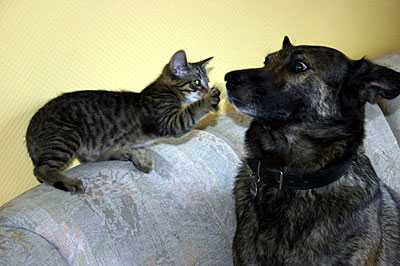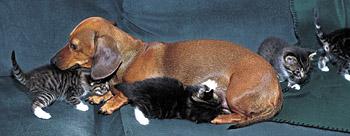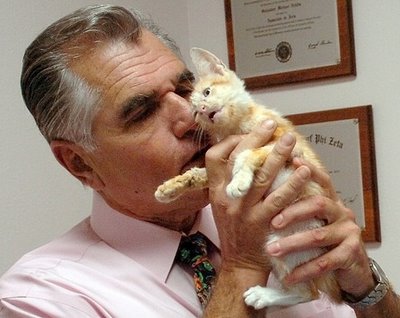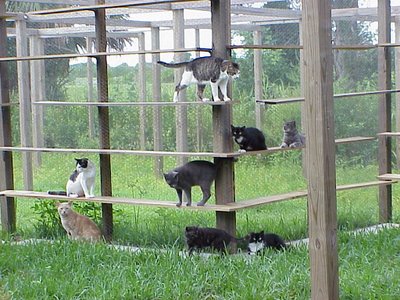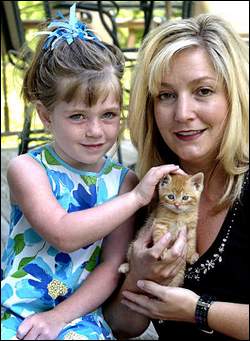
"Atrocities are not less atrocities when they occur in laboratories and are called medical research."
-- George Bernard Shaw
Allerca Lifestyle Pets of San Diego announced last month that it had created the world's first hypoallergenic cat. The Scripps Research Institute (TSRI) of La Jolla is currently carrying out controlled trials and if all goes well these cats are expected to become commercially available sometime next year.
As is usually the case whenever the scientific community and the capitalists get together in order to manipulate some defenseless species, the details of the so-called breakthrough are shrouded in secrecy. Not only do they not want animal rights activists to know what they have been up to but they also want to keep their
modus operandi secret from their competitors in the lucrative designer pet field.
If Allerca can be believed, its researchers analyzed the genes of English and American Shorthairs, like the one shown in the photo above, in order to isolate those proteins believed to provoke allergic reactions in humans. They then selectively bred an undisclosed number of cats over several generations in order to create more than twenty hypoallergenic cats.
(See The Times of London, June 4, 2006, "Clinical Kitty: Science Comes Up with Non-Allergy Cat.")Even these sketchy details raise serious animal welfare issues. First of all, where does Allerca get the cats that it manipulates? Most likely it gets them from a company that specifically breeds cats for research labs or possibly through pound seizure. In either case, both procurement methods should be outlawed.
Secondly, in order to selectively breed its allergy-free cats Allerca has to imprison large numbers of felines in cramped cages for their entire lives. DNA samples have to be taken and other tests performed on a more or less daily basis. Much the same
de rigueur no doubt applies to the actual breeding itself whether it be natural, forced, or artificially induced.
Allerca stated recently that it had originally entertained the idea of using genetic manipulation in order to achieve its goal but that it had been forced to abandon that idea because of fears of side effects. That admission neglects to point out that selective breeding is fraught with the same problems. By controlling for genes that produce allergies, scientists are at the same time subjecting cats to a thousand other defects and maladies.
More importantly, what does Allerca do with its cats after it is finished manipulating them? It no doubt repays them for their valuable contributions to the "advancement of science" by exterminating them
en masse.As far as conditions at its laboratory are concerned, Allerca has been equally evasive, stating only that it complies with guidelines established by the USDA. That is not saying much. The Agriculture Department concerns itself only with such mundane animal welfare issues as cage size and feeding requirements. These good-for-nothing, bought and paid for capitalist pimps do not involve themselves with either animal torture or murder. According to this perverted logic, it is perfectly all right to torture, cripple, and even kill defenseless animals so long as they are fed and watered once a day and provided with enough space in order to lie down.

The capitalist media around the world have treated this development as a curiosity item without raising so much as an iota of concern about the welfare of the cats at Allerca's lab.
Allergy-free cats have long been coveted by people who are allergic to a protein found in the sebaceous glands of cats' skin and in their saliva. This protein is also dispersed throughout their fur during grooming. Itchy, watery, and swollen eyes, runny noses, sneezing, and breathing difficulties are common symptoms shared by individuals allergic to cats.
These cats are not going to be cheap, however. According to
The Times of London article cited
supra, they are expected to fetch about $15,000 apiece in Old Blighty and that figure does not include shipping, quarantine, and insurance.
Stern, considerably more conservative in its estimate, predicted in its June 8th edition that they would cost as little as 3,100 euros.
(See "2007 kommt die Katze fur Allergiker.")With there being 2.6 million asthma sufferers in England and many times more that number on the Continent and in the United States, demand for these specially-bred felines is expected to be high. "Ab 2009 wollen wir jahrlich 10,000 dieser Haustiere zuchten," Allerca's Megan Young is quoted by
Stern as saying in the article cited
supra.Animal rights groups were quick to condemn the development. James Kirkwood of the Companion Animal Welfare Council told
The Times that selective breeding can only be justified if it is necessary for a cat's well-being and that the creation of hypoallergenic cats clearly does not meet that standard.
The Royal Society for the Prevention of Cruelty to Animals (RSPCA) put its finger on the heart of the matter when it stated that selective breeding "undermines the value of animal life." The organization went on to warn that "genetic modification and selective breeding can produce health effects that don't become apparent until further down the track."
Regardless of whether the reproductive method involves selective breeding, genetic alteration, hybridization, or cloning, the creation of hypoallergenic cats is another step down a dark and perilous road that treats cats and other animals as little more than matter to be manipulated for man's benefit. Morally bankrupt scientists and capitalists undertake this sort of research for the money and glory that equally morally perverse consumers are willing to shell out for the hideous products that it produces.
While it is true that a large number of individuals who dump cats at shelters to be exterminated attempt to excuse their abysmal cruelty by citing feline-borne allergies, they neglect to acknowledge that they had no business owning a cat in the first place. These claims are largely bogus anyway because there are numerous humane measures that cat-owners can take in order to substantially reduce allergic reactions to their cats.
Since cats generally do not care too much for water it will take some doing but frequently bathing a cat, particularly around its face, can greatly cut down on allergic reactions. For those less industrious, allergy wipes, such as Allerpet, are available. If it can be done safely, cats should be allowed outside so that some of the allergens that collect in their fur can be allowed to dissipate into the fresh air.

It is also a good idea to frequently clean houses and apartments and to keep them well ventilated. Items that collect huge amounts of allergens, such as carpeting and heavy drapes, can be replaced and other allergy causing substances, such as smoke, dust, mold, candles, chemicals, and pollen, can be easily eliminated from the home. Needless to say, individuals allergic to cats should not sleep with them.
As is the case with avoiding
die Grippe and the common cold, maintaining proper personal hygiene is essential if allergic reactions are to be reduced. For instance, hands should be washed frequently with hot water and soap, especially after handling a cat, and kept away from the mouth, nose, and eyes at all times. Wearing apparel and bedding should be laundered frequently. Also, cotton clothing generally attracts fewer allergens than does wool.
Clearly, it is far more humane to reduce allergens in the home than to barbarously selectively breed cats. Interfering with the feline reproductive cycle is even more barbaric than mass sterilizations, onychetomies, and the American Bird Conservancy's campaign to imprison cats indoors.
For those individuals too lazy to undertake these remedial measures the lesson is clear: get a dog, a rabbit, a pig, or any other animal but leave cats alone! They are not toys to be manipulated in order to satisfy the whims of consumers who are so morally bent that they are unable to distinguish between animate and inanimate objects. Cats are sentient beings who are entitled to be left alone.
More to the point, with an estimated ten million cats being exterminated at shelters in the United States each year
(See photo at the bottom of the page of cats awaiting adoption at St. Francis Animal Rescue, a no-kill shelter in South Venice, Florida) and another sixty million without homes, the world certainly does not need any more cats, especially designer felines.
As cruel and inhumane as selective breeding is, it is merely one of several poisonous arrows that the scientific community has in its ever-expanding quiver. For instance, scientists have created more than four-hundred-thirty-five new hybrids. Wild African Servals have been bred with domestic cats to create a new breed called Savannahs.
(See photo above as well as Cat Defender post of May 19, 2005 entitled "Savannahs: More Feline Cruelty Courtesy of the Capitalists and the Bourgeoisie.") In addition to Savannahs and allergy-free cats, scientists have created a labrador and poodle mix called a labradoodle and a pug and beagle mix called a puggie.

Scientists have also cloned more than a dozen animals including domestic cats such as the lovely CC
(See photo above) and the clones of African Wildcats have been successfully bred.
(See Cat Defender post of September 6, 2005 entitled "Clones of Endangered African Wildcats Give Birth to Eight Naturally-Bred Healthy Kittens in New Orleans.") The difficult riddle of canine cloning was finally solved last year when now disgraced stem cell pioneer Hwang Woo Suk produced Snuppy.
(See Cat Defender post of August 15, 2005 entitled "South Koreans Clone World's First Dog; Vivisectors and Stem Cell Proponents See $$$.")Of all the scientific community's evil deeds, its attempt to tag all animals of the world with RFID or similar technologies is its most ambitious effort. Once this project succeeds, scientists will be able to determine at the click of a mouse not only which animals are going to be allowed to go on living but under what circumstances. Man, of course, will be next on their hit list.
(See Cat Defender post of May 4, 2006 entitled "Scientific Community's Use of High-Tech Surveillance Is Aimed at Subjugating, Not Saving, the Animals.")The scientific community is comprised primarily of godless fascists who spend their entire lives alternately living off of welfare and pimping and whoring for the capitalists. Without scientists, the subjugation of the animals would not be possible, nuclear weapons and other instruments of mass destruction would not exist, and Mother Earth would not be dying as the result of the poisonous chemicals that they have created in their laboratories.
Rather than wasting precious time and energy trying to reform corrupt political and economic systems, it might be far more productive for concerned individuals to target universities. Too many evil professors have gotten away with too many crimes for too long by hiding behind the cloak of intellectual respectability. It is high time that this cloak was stripped away and their sources of funding revealed and their morals and ethics placed under the microscope.
Photos: Stefan Kiefer of DDP for Stern (domestic cat), Gulf Coast Exotic Felines (Savannah), Richard Olsenius (CC), and Danielle Rappaport of the Sarasota Herald-Tribune (Caged cats at St. Francis Animal Rescue).






